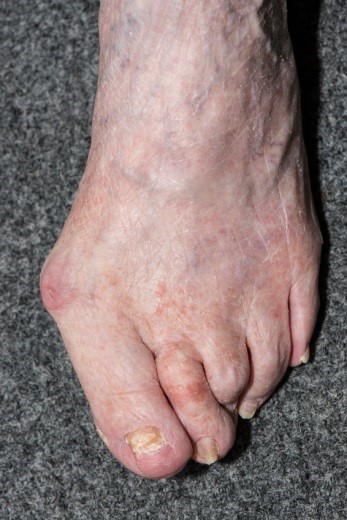Blog
Roy Returns to Mountain Climbing after Hammertoe Amputation
 Last May, Basanta Kumar Singha Roy, a 53-year-old banker, was attempting to climb down Dhaulagiri after a failed expedition when he noticed that a breach in his oxygen tank was causing the air to leak out. His climbing partner hurried back to camp to get help while Roy waited on the mountainside. His feet began to go numb, and eventually he passed out.
Last May, Basanta Kumar Singha Roy, a 53-year-old banker, was attempting to climb down Dhaulagiri after a failed expedition when he noticed that a breach in his oxygen tank was causing the air to leak out. His climbing partner hurried back to camp to get help while Roy waited on the mountainside. His feet began to go numb, and eventually he passed out.
Luckily Roy was rescued and brought to a hospital in Kathmandu. Doctors amputated a few of his toes, including a hammertoe he had on his right foot. Since then Roy has been trying to prepare for a new expedition: climbing to the top of the Neelkanth peak in the Himalayas. If he makes it he’ll be the first Indian civilian to scale the summit. “Making a comeback was not that tough, because mountaineering has been a passion all my life and I owe it to my family because of their full support,” Roy said.
Hammertoes are a type of painful toe deformity than can make walking very hard. If you notice one of your toes curling in an unnatural way, talk to podiatrist Dr. Michael Newman, DPM of Pennsylvania. Dr. Newman will provide you with a fitting form of treatment and help you get back to full health.
Hammertoe
Hammertoe is little-known a painful condition that affects the second, third and fourth toes involving different joints of the toe and foot. Hammertoe can be caused by many other conditions such as RA (rheumatoid arthritis), osteoarthritis, trauma or injuries to your foot, it can be hereditary and it can also be caused by a cerebral vascular accident. If you wear shoes that are too narrow or short for your feet, it may exacerbate any pain you already have.
It is really important to your overall well-being to seek out medical attention at the first signs of foot pain or anything that may hinder your ability to walk in a normal manner. Taking care of your feet is one of the first steps to being able to live a full and healthy life.
If you have any questions, feel free to contact our offices in Plymouth Meeting and Ambler, PA. We offer the latest diagnostic and treatment technologies for all your foot care needs.
Read more about Hammertoes
Cowboys Player Breaks Foot During Practice
 As the replacement for DeMarcus Ware, the Dallas Cowboys’ old defensive end, DeMarcus Lawrence has an important role to play in the team’s defense lineup. But unfortunately the rookie player won’t be able to prove himself just yet because of a broken foot he sustained during a recent practice.
As the replacement for DeMarcus Ware, the Dallas Cowboys’ old defensive end, DeMarcus Lawrence has an important role to play in the team’s defense lineup. But unfortunately the rookie player won’t be able to prove himself just yet because of a broken foot he sustained during a recent practice.
Lawrence was participating in a drill with teammate Tyron Smith when Smith blocked his attempt a speed rush, causing him to fall to the ground. He landed awkwardly on his foot and had to be assisted off the field. Lawrence’s injury will keep him sidelined for at least 8 weeks as he recovers.
The type of foot injury Lawrence sustained on the field is common but potentially serious. If you think you might have a broken bone in your foot, visit podiatrist Dr. Michael Newman, DPM of Pennsylvania. Dr. Newman can diagnose your injury and provide you with foot care of an unparalleled quality.
Broken Foot Causes, Symptoms, and Treatment
A broken foot is caused by one of the bones in the foot ‘breaking’, or fracturing. Bones typically break when the bone is either bended, crushed, or stretched beyond its natural capabilities. Usually the location of the fracture indicates how the break occurred, whether it was through an object, fall, or any other type of injury.
Common Symptoms of Broken Feet:
- Bruising
- Pain
- Redness
- Swelling
- Blue (foot)
- Numbness
- Cold
- Misshapen
- Cuts
- Deformities
Those who are experiencing any of these symptoms, or suspect that they have a broken foot, should seek medical attention in a center where x-rays can be performed. This is especially urgent if any of the symptoms include numbness, blue coloring, cold feet, cuts, misshapen toes or deformities as these indicate more severe cases.
Treatment for broken bones varies depending on the cause, severity and location. Some will require the use of splints, casts or crutches while others could even involve surgery to repair the broken bones. Personal care includes the use of ice and keeping the foot stabilized and elevated. Trying to keep the foot rested is important as the bones need plenty of time to heal and recover.
If you have any questions, feel free to contact our offices in Plymouth Meeting and Ambler, PA. We offer the latest diagnostic and treatment technologies for all your foot care needs.
Read more about Broken Feet
Study Shows Soda Raises Probability of Getting Rheumatoid Arthritis
 Findings from the Nurses’ Health Study and the Nurses’ Health Study II show that drinking sugary soda frequently could increase some women’s chances of getting rheumatoid arthritis (RA). Scientists studied more than 180,000 U.S. women and discovered that those who drank at least one serving of soda a day had a 63% greater chance of developing seropositive RA than those who didn’t.
Findings from the Nurses’ Health Study and the Nurses’ Health Study II show that drinking sugary soda frequently could increase some women’s chances of getting rheumatoid arthritis (RA). Scientists studied more than 180,000 U.S. women and discovered that those who drank at least one serving of soda a day had a 63% greater chance of developing seropositive RA than those who didn’t.
Drinking a lot of soda has been known to cause a lot of other health problems as well, including cardiovascular illness and Type 2 diabetes. The researchers conducting the Nurses’ Health Studies found no correlation between soda and seronegative RA. They also concluded that diet soda had little impact on the women’s chances of getting arthritis.
If you have rheumatoid arthritis in your feet, you could probably benefit from treatment from a medical professional. To get help with the symptoms of your RA, see podiatrist Dr. Michael Newman, DPM of Pennsylvania. Dr. Newman will evaluate the severity of your condition and do everything he can to ease your discomfort.
What Is Rheumatoid Arthritis?
Rheumatoid Arthritis (RA) is an autoimmune disorder in which the body’s own immune system attacks the membranes surrounding the joints. Inflammation of the lining and eventually the destruction of the joint’s cartilage and bone occurs, causing severe pain and immobility.
Rheumatoid Arthritis of the Feet
Although RA usually attacks multiple bones and joints throughout the entire body, almost 90 percent of cases result in pain in the foot or ankle area. Pain often initially presents in the toes before the condition worsens and spreads throughout the entire foot. Rheumatoid arthritis appears to be genetically inherited, so if you have a family history of RA, you may be predisposed to suffer from it as well.
Symptoms
- Swelling & pain in the feet
- Stiffness in the feet
- Pain on the ball or sole of feet
- Joint shift and deformation
Diagnosis
Quick diagnosis of RA in the feet is important so that the podiatrist can treat the area effectively. Your doctor will ask you about your medical history, occupation, and lifestyle to determine the origin of the condition.
For more information about Rheumatoid Arthritis, follow the link below.
If you have any questions, feel free to contact our offices in Plymouth Meeting and Ambler, PA. We offer the latest diagnostic and treatment technologies for all your foot care needs.
Read more about Rheumatoid Arthritis
